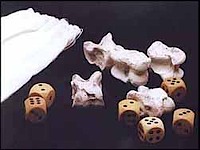By Leean Lester
Greetings, everyone. For this month’s column, I decided to talk about the divination of Sortilege. Also known as Cleromancy, the method involves reading with dice. This
divination goes back to about 1260 B. C. E., and was common in Babylon and in Assyria. Usually the dice were made from clay or from the bone knuckles of sheep or other animals, with dots on them like the dots on today’s dice. The number of the dice used for divination usually depended on the region. In Tibetan So-Mo, 3 dice were used, allowing for 16 values (3 – 18 ). In Medieval Europe, one dice was rolled several times. During the Victorian American Era, 2 dice were used, and it was usually done on a Monday or Wedensday.
Cleromancy / Sortilege (dice reading)
1 = self; hermitage; time alone / downtime
2 = partnership; companionship, equity
3 = happy surprise or event
4 = troubles, obstacle, or unpleasant encounters
5 = fulfillment of hopes
6 = some type of loss or setback
7 = business or financial difficulties; undeserved slander
8 = misunderstandings (often due to poor communication)
9 = unity; success; end to argument or problem
10 = new beginning
11 = separation; moving away; distraction
12 = important news forthcoming
13 = sadness; depression; foreboding
14 = blossoming of a new friendship or partnership
15 = hold off on plans; ill-motivated people
16 = travel or adventure
17 = change your strategy or methods
18 = good fortune and victory
Die-casting Circle:
Draw a circle and divide it into 12 areas. Label each area as follows:
1 = the future (this question isn’t finished yet)
2 = money issues
3 = movement
4 = home and family
5 = present / personally meaningful
6 = physical health
7 = relationships
8 = legal matters
9 = mental well-being
10 = job / career
11 = obstacles
12 = spiritual progress
Dice Reading Values and interpretation:
Using 2 dice, add up the value and check the table for the meanings.
1 = yes or go ahead
2 = no or stop
3 = be careful, but things are not as bad as you think
4 = consider your options carefully
5 = improved fortune; don’t loose hope
6 = good sign for new projects
7 = faith (or instincts) will guide you
8 = patience is necessary – don’t rush
9 = there’s no need to wait
10 = your doubts are well-founded
11 = you already know the answer in your heart
12 = unlikely – reconsider your goals
I’d like to talk about perception of things, about how everything’s a mental illusion in life. We perceive things the way we want them to be. We only see the surface and not what’s below it. When seeing only the surface, sometimes we tend to miss or overlook details, or not get the whole picture.
If you look at things from many different angles, you can see so much more than what is really there. This is where the old saying comes into play: Reality is what you make of it, and nothing is ever what is seems to be.
In order to be truly happy in life, one must live as they say, by seizing the moments, making the most of each day and not looking back, with no regrets about anything that we’ve done, said, or otherwise took part in.
You have to live your life by your own set of rules and by what works for you. It doesn’t work if you try living up to everyone’s expectations and not your own. You will only end up spending more time than you’d like, and wasting energy; not being happy or satisfied.
I’ve learned that in order to be happy with the life you have, with who you are, you go through this world with a somewhat cold-hearted attitude, doing, saying, or whatever it be that pleases you; as long as you’re not doing harm to anyone or yourself, if people don’t like it, that’s just too bad. You’re not here to make them happy or to be their “slave,” but to live life the way it works for you.
So to close, as my dear granny use to say, “There’s the screen door; if you don’t like it, get out of the way, and if the screen door hits your tail end, then you should have been moving faster.” Until next time from The Soothsayer’s Corner, many blessings.
